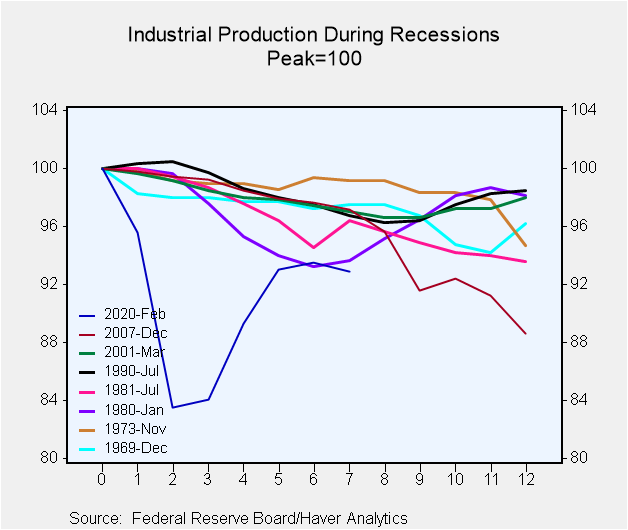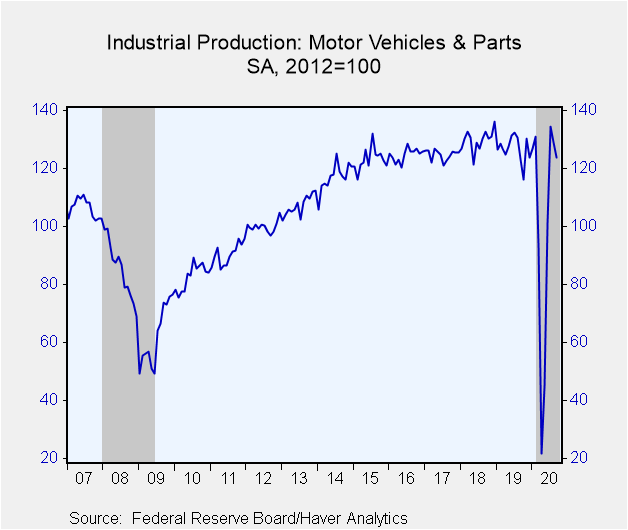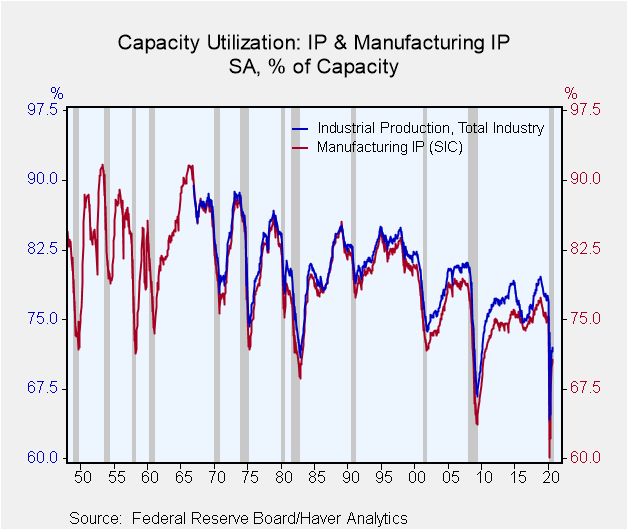 Global| Oct 16 2020
Global| Oct 16 2020U.S. Industrial Production Takes Breather in September
Summary
• Industrial production declined 0.6% in September after four months of gains; production 7.1% from February. • Manufacturing decreased 0.3%; 6.4% below February level. • Motor vehicle output down for second consecutive month. [...]
• Industrial production declined 0.6% in September after four months of gains; production 7.1% from February.
• Manufacturing decreased 0.3%; 6.4% below February level.
• Motor vehicle output down for second consecutive month.
Industrial production fell 0.6% in September (-7.3% year-on-year) after four consecutive monthly gains and an unrevised 0.4% increase in August. The Action Economics Survey forecast a 0.7% growth in September. This leaves industrial production 7.1% below February and at 2016 levels (output peaked in December 2018).
Manufacturing production declined 0.3% in September (-6.0% y/y) with August revised up to 1.2% from 1.0%. This leaves factory output 6.4% below February and at 2011 levels. Utilities dropped 5.6% (-6.1% y/y) while mining rose 1.7% (-14.8% y/y).
Manufacturing of durable goods fell 0.5% in September (-7.1% y/y) led by a 4.0% drop in motor vehicles (+0.4% y/y). This is the second consecutive monthly decline of this magnitude for the auto sector. After rebounding from being down 84 percentage points (ppt) in April to +2.8 ppt in July, vehicle output is now 5.5% below the February level. The aerospace industry continues to show healthy gains, up 4.6% in in September, though it is still down 5.4% from February. Nondurable output was unchanged (-4.2% y/y) and remains 4.8% from pre-COVID levels; July 2018 was the peak for nondurable production.
Output of business equipment, an indicator of capital spending, declined 1.2% in September (-11.1% y/y) after four monthly increases, leaving it 8.8% below February levels.
Capacity utilization declined to 71.5% in September, well below the 76.9% in February and 79.6% cyclical peak in November 2018. The Action Economics Survey expected 71.9% in September. Factory sector use decreased to 70.5% versus 75.2% in February and the cyclical peak of 77.3% in December 2018.
Industrial production and capacity and oil prices are located in Haver's USECON database. Additional detail on production and capacity can be found in the IP database. The expectations figures come from the AS1REPNA database.
| Industrial Production (SA, % Change) | Sep | Aug | Jul | Sep Y/Y | 2019 | 2018 | 2017 |
|---|---|---|---|---|---|---|---|
| Total Output | -0.6 | 0.4 | 4.2 | -7.3 | 0.9 | 3.9 | 2.3 |
| Manufacturing | -0.3 | 1.2 | 4.2 | -6.0 | -0.2 | 2.3 | 2.0 |
| Durable Goods | -0.5 | 0.6 | 7.2 | -7.1 | 0.7 | 3.4 | 2.2 |
| Motor Vehicles | -4.0 | -4.3 | 33.0 | 0.4 | -2.4 | 4.1 | 0.0 |
| Selected High Tech | 0.8 | 1.3 | 2.2 | 5.8 | 5.1 | 6.4 | 2.6 |
| Nondurable Goods | 0.0 | 1.7 | 1.4 | -4.2 | -0.7 | 1.9 | 1.9 |
| Utilities | -5.6 | -1.0 | 4.9 | -6.1 | -0.8 | 4.4 | -0.8 |
| Mining | 1.7 | -2.4 | 3.7 | -14.8 | 7.1 | 12.4 | 7.4 |
| Capacity Utilization (%) | 71.5 | 72.0 | 71.6 | 77.4 | 77.8 | 78.7 | 76.5 |
| Manufacturing | 70.5 | 70.7 | 69.8 | 75.1 | 75.6 | 76.6 | 75.1 |
Gerald D. Cohen
AuthorMore in Author Profile »Gerald Cohen provides strategic vision and leadership of the translational economic research and policy initiatives at the Kenan Institute of Private Enterprise.
He has worked in both the public and private sectors focusing on the intersection between financial markets and economic fundamentals. He was a Senior Economist at Haver Analytics from January 2019 to February 2021. During the Obama Administration Gerald was Deputy Assistant Secretary for Macroeconomic Analysis at the U.S. Department of Treasury where he helped formulate and evaluate the impact of policy proposals on the U.S. economy. Prior to Treasury, he co-managed a global macro fund at Ziff Brothers Investments.
Gerald holds a bachelor’s of science from the Massachusetts Institute of Technology and a Ph.D. in Economics from Harvard University and is a contributing author to 30-Second Money as well as a co-author of Political Cycles and the Macroeconomy.









